Xingxing Zou
FashionM3: Multimodal, Multitask, and Multiround Fashion Assistant based on Unified Vision-Language Model
Apr 24, 2025Abstract:Fashion styling and personalized recommendations are pivotal in modern retail, contributing substantial economic value in the fashion industry. With the advent of vision-language models (VLM), new opportunities have emerged to enhance retailing through natural language and visual interactions. This work proposes FashionM3, a multimodal, multitask, and multiround fashion assistant, built upon a VLM fine-tuned for fashion-specific tasks. It helps users discover satisfying outfits by offering multiple capabilities including personalized recommendation, alternative suggestion, product image generation, and virtual try-on simulation. Fine-tuned on the novel FashionRec dataset, comprising 331,124 multimodal dialogue samples across basic, personalized, and alternative recommendation tasks, FashionM3 delivers contextually personalized suggestions with iterative refinement through multiround interactions. Quantitative and qualitative evaluations, alongside user studies, demonstrate FashionM3's superior performance in recommendation effectiveness and practical value as a fashion assistant.
From Fragment to One Piece: A Survey on AI-Driven Graphic Design
Mar 24, 2025Abstract:This survey provides a comprehensive overview of the advancements in Artificial Intelligence in Graphic Design (AIGD), focusing on integrating AI techniques to support design interpretation and enhance the creative process. We categorize the field into two primary directions: perception tasks, which involve understanding and analyzing design elements, and generation tasks, which focus on creating new design elements and layouts. The survey covers various subtasks, including visual element perception and generation, aesthetic and semantic understanding, layout analysis, and generation. We highlight the role of large language models and multimodal approaches in bridging the gap between localized visual features and global design intent. Despite significant progress, challenges remain to understanding human intent, ensuring interpretability, and maintaining control over multilayered compositions. This survey serves as a guide for researchers, providing information on the current state of AIGD and potential future directions\footnote{https://github.com/zhangtianer521/excellent\_Intelligent\_graphic\_design}.
FonTS: Text Rendering with Typography and Style Controls
Nov 28, 2024Abstract:Visual text images are prevalent in various applications, requiring careful font selection and typographic choices. Recent advances in Diffusion Transformer (DiT)-based text-to-image (T2I) models show promise in automating these processes. However, these methods still face challenges such as inconsistent fonts, style variation, and limited fine-grained control, particularly at the word level. This paper proposes a two-stage DiT-based pipeline to address these issues by enhancing controllability over typography and style in text rendering. We introduce Typography Control (TC) finetuning, an efficient parameter fine-tuning method, and enclosing typography control tokens (ETC-tokens), which enable precise word-level application of typographic features. To further enhance style control, we present a Style Control Adapter (SCA) that injects style information through image inputs independent of text prompts. Through comprehensive experiments, we demonstrate the effectiveness of our approach in achieving superior word-level typographic control, font consistency, and style consistency in Basic and Artistic Text Rendering (BTR and ATR) tasks. Our results mark a significant advancement in the precision and adaptability of T2I models, presenting new possibilities for creative applications and design-oriented tasks.
Dress Well via Fashion Cognitive Learning
Aug 01, 2022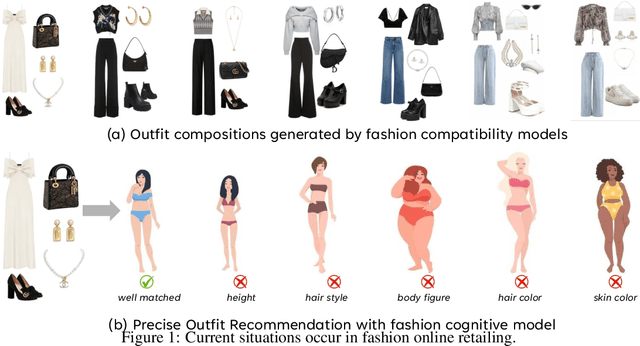
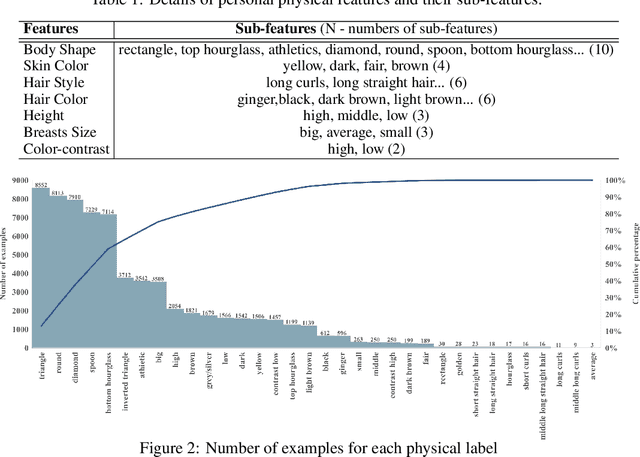
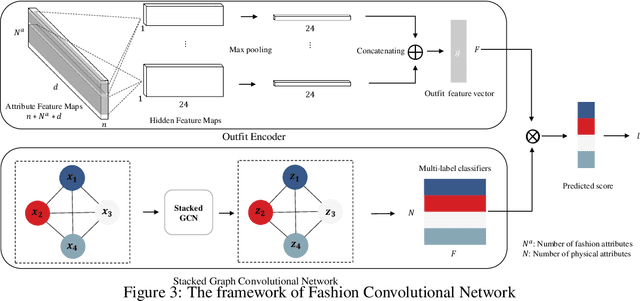
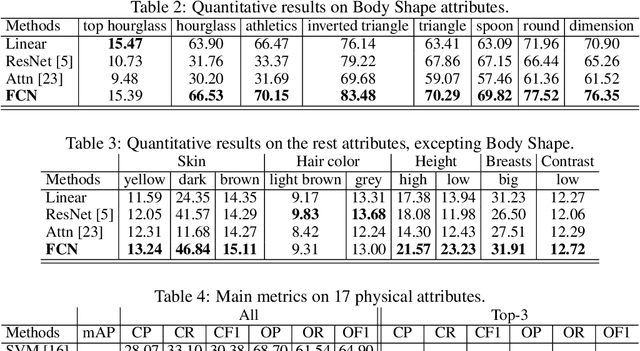
Abstract:Fashion compatibility models enable online retailers to easily obtain a large number of outfit compositions with good quality. However, effective fashion recommendation demands precise service for each customer with a deeper cognition of fashion. In this paper, we conduct the first study on fashion cognitive learning, which is fashion recommendations conditioned on personal physical information. To this end, we propose a Fashion Cognitive Network (FCN) to learn the relationships among visual-semantic embedding of outfit composition and appearance features of individuals. FCN contains two submodules, namely outfit encoder and Multi-label Graph Neural Network (ML-GCN). The outfit encoder uses a convolutional layer to encode an outfit into an outfit embedding. The latter module learns label classifiers via stacked GCN. We conducted extensive experiments on the newly collected O4U dataset, and the results provide strong qualitative and quantitative evidence that our framework outperforms alternative methods.
fAshIon after fashion: A Report of AI in Fashion
May 07, 2021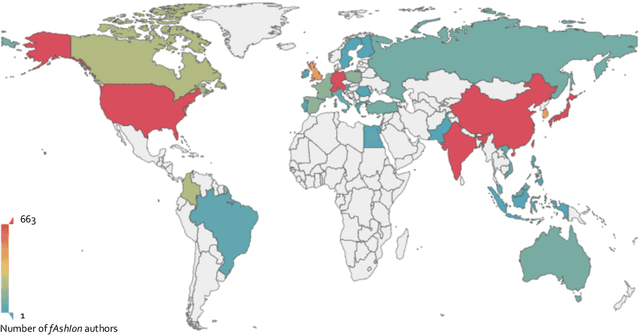



Abstract:In this independent report fAshIon after fashion, we examine the development of fAshIon (artificial intelligence (AI) in fashion) and explore its potentiality to become a major disruptor of the fashion industry in the near future. To do this, we investigate AI technologies used in the fashion industry through several lenses. We summarise fAshIon studies conducted over the past decade and categorise them into seven groups: Overview, Evaluation, Basic Tech, Selling, Styling, Design, and Buying. The datasets mentioned in fAshIon research have been consolidated on one GitHub page for ease of use. We analyse the authors' backgrounds and the geographic regions treated in these studies to determine the landscape of fAshIon research. The results of our analysis are presented with an aim to provide researchers with a holistic view of research in fAshIon. As part of our primary research, we also review a wide range of cases of applied fAshIon in the fashion industry and analyse their impact on the industry, markets and individuals. We also identify the challenges presented by fAshIon and suggest that these may form the basis for future research. We finally exhibit that many potential opportunities exist for the use of AI in fashion which can transform the fashion industry embedded with AI technologies and boost profits.
Regularizing Reasons for Outfit Evaluation with Gradient Penalty
Feb 02, 2020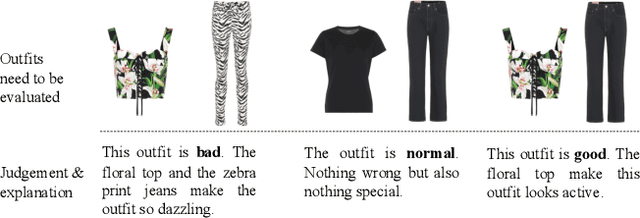

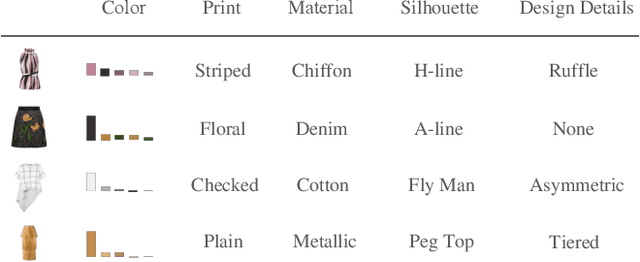
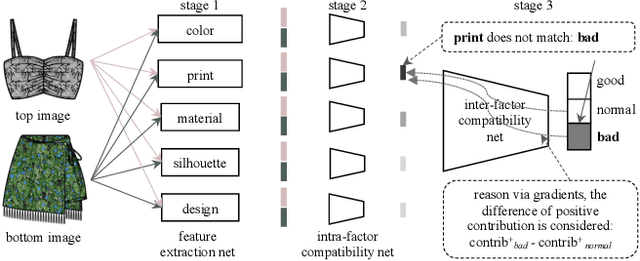
Abstract:In this paper, we build an outfit evaluation system which provides feedbacks consisting of a judgment with a convincing explanation. The system is trained in a supervised manner which faithfully follows the domain knowledge in fashion. We create the EVALUATION3 dataset which is annotated with judgment, the decisive reason for the judgment, and all corresponding attributes (e.g. print, silhouette, and material \etc.). In the training process, features of all attributes in an outfit are first extracted and then concatenated as the input for the intra-factor compatibility net. Then, the inter-factor compatibility net is used to compute the loss for judgment. We penalize the gradient of judgment loss of so that our Grad-CAM-like reason is regularized to be consistent with the labeled reason. In inference, according to the obtained information of judgment, reason, and attributes, a user-friendly explanation sentence is generated by the pre-defined templates. The experimental results show that the obtained network combines the advantages of high precision and good interpretation.
 Add to Chrome
Add to Chrome Add to Firefox
Add to Firefox Add to Edge
Add to Edge